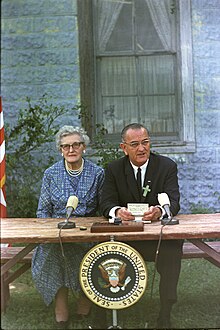 | |
| Enacted by | the 89th United States Congress |
|---|---|
| Citations | |
| Public law | Pub. L. 89–10 |
| Statutes at Large | 79 Stat. 27 |
| Codification | |
| Acts amended | Pub. L. 81–874, 64 Stat. 1100; Pub. L. 83–531, 68 Stat. 533 |
| Titles amended | 20 U.S.C.: Education |
| U.S.C. sections created | 20 U.S.C. ch. 70 |
| Legislative history | |
| |
| Major amendments | |
| Bilingual Education Act Education Amendments of 1972 Equal Educational Opportunities Act of 1974 Improving America's Schools Act of 1994 No Child Left Behind Act Every Student Succeeds Act | |

| This article is part of a series on |
| Education in the United States |
|---|
| Summary |
| Issues |
| Levels of education |
|
|
The Elementary and Secondary Education Act (ESEA) was passed by the 89th United States Congress and signed into law by President Lyndon B. Johnson on April 11, 1965. Part of Johnson's "War on Poverty", the act has been one of the most far-reaching pieces of federal legislation affecting education ever passed by the United States Congress, and was further emphasized by the revised No Child Left Behind Act of 2001.
Johnson proposed a major reform of federal education policy in the aftermath of his landslide victory in the 1964 United States presidential election, and his proposal quickly led to the passage of the Elementary and Secondary Education Act. The act provides federal funding to primary and secondary education, with funds authorized for professional development, instructional materials, resources to support educational programs, and parental involvement promotion. The act emphasizes equal access to education, aiming to shorten the achievement gaps between students by providing federal funding to support schools with children from impoverished families.
Since 1965, ESEA has been modified and reauthorized by Congress several times. The Bilingual Education Act provides support for bilingual education and educational efforts for Native Americans and other groups. The Equal Educational Opportunities Act of 1974 prohibits discrimination against students and teachers. The No Child Left Behind Act (NCLB) introduced a testing regime designed to promote standards-based education. The Every Student Succeeds Act retained some of the testing requirements established by the NCLB, but shifted accountability provisions to the states.[1]
- ^ Vinovskis, Maris (August 2022). "Federal Compensatory Education Policies from Lyndon B. Johnson to Barack H. Obama". History of Education Quarterly. 62 (3): 243–267. doi:10.1017/heq.2022.21. S2CID 250533597.
© MMXXIII Rich X Search. We shall prevail. All rights reserved. Rich X Search
